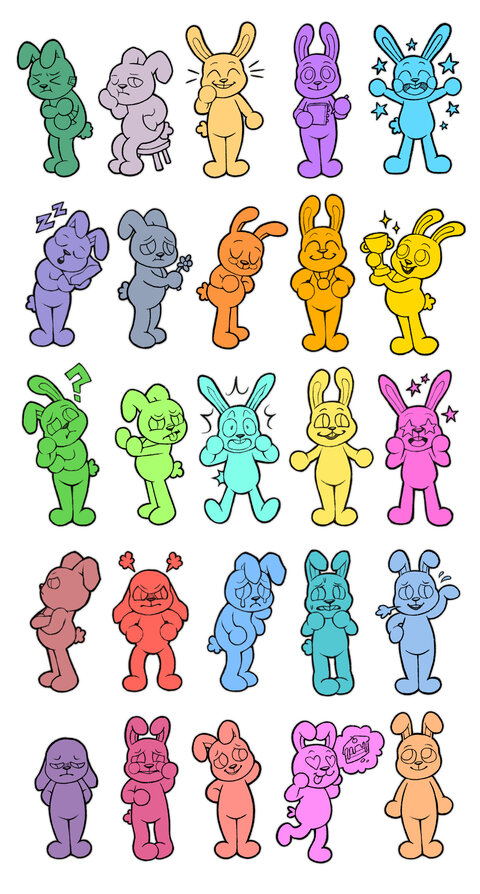'How are you feeling right now?' Cartoons for emotional self-assessment for people with chronic respiratory diseases
People with chronic respiratory diseases (CRD) often experience a variety of emotions related to their symptoms and the limitations that they cause, including breathlessness, social isolation and lack of physical activity. These emotions are often not recognised by the individual themselves, their families or healthcare professionals.
It is normal to feel low from time to time, whether you have chronic respiratory disease or not. Problems can occur if negative emotions get "stuck" and persist for longer periods of time. We want to encourage people with chronic respiratory disease to identify and act on how they are feeling, so that positive emotions are more easily identifiable and ways can be found to maintain them and create more space for them. If negative emotions exist, ways can then also be found to shift them including seeking further support. This tool is designed to help start that process of recognition by asking "how are you feeling right now?"
We asked Masters students of cartooning at Teesside University (UK) to design a set of cartoons that depict a range of emotions that have been identified by academic psychologists as the main emotions we all experience across different cultures and countries. The result is a set of 25 cartoons. The designs were evaluated and chosen by experts in our network for readability, consistency and layout, ease of distinction, global health applicability and adherence to specific details such as facial muscles as identified in the research.
How to use the cartoons
If you are someone with chronic respiratory disease, take a look at the cartoons and pick which represents how you feel at the moment. You may find that there are several cartoons which show how you feel. Reflect on whether these are emotions you want and, if so, what made you feel this way. If they are emotions you don't want, consider what has caused them and what might help shift your mood. This may include talking to family, friends or a healthcare professional.
If you are with someone with chronic respiratory disease, ask them to take a look and tell you which cartoon best reflects how they feel now. Use this to start a conversation about whether this is an emotion they want and, if so, what made them feel this way. If it is an emotion they don't want, consider what has caused it and what might help shift it, and offer your support.
The set of cartoons can be used to teach the following process of identifying and managing mood and emotions:
- Identification of the emotion
- Understanding of the emotion and the needs behind it
- Controlling the emotion’s intensity
- Expressing the emotion to inform others about your needs, seek help, or share your happiness
- Use your emotion to take action
These cartoons are not specific to chronic respiratory diseases and are intended as a resource for primary care to encourage emotional self-assessment for many conditions.
The emotions depicted, in left-right reading order, are pain, boredom, amusement, interest, ecstasy, tiredness, sympathy, gratitude, pride, triumph, confusion, disgust, surprise, happiness, awe, contempt, anger, sadness, fear, relief, shame, embarrassment, coyness, desire and contentment.
The illustrations are available with and without labels. Files for the individual emotions will be made available in the future.
References & acknowledgments
- Keltner D. Toward a consensual taxonomy of emotions. Cogn Emot. 2019 Feb;33(1):14-19. doi: 10.1080/02699931.2019.1574397. Epub 2019 Feb 22. PMID: 30795713.
- Keltner D, Sauter D, Tracy J, Cowen A. Emotional Expression: Advances in Basic Emotion Theory. J Nonverbal Behav. 2019 Jun;43(2):133-160. doi: 10.1007/s10919-019-00293-3. Epub 2019 Feb 7. PMID: 31395997; PMCID: PMC6687086.
- Cordaro DT, Sun R, Kamble S, Hodder N, Monroy M, Cowen A, Bai Y, Keltner D. The recognition of 18 facial-bodily expressions across nine cultures. Emotion. 2020 Oct;20(7):1292-1300. doi: 10.1037/emo0000576. Epub 2019 Jun 10. PMID: 31180692; PMCID: PMC6901814.
- Cordaro DT, Sun R, Keltner D, Kamble S, Huddar N, McNeil G. Universals and cultural variations in 22 emotional expressions across five cultures. Emotion. 2018 Feb;18(1):75-93. doi: 10.1037/emo0000302. Epub 2017 Jun 12. PMID: 28604039.
Illustrations: Alex Crawford (Instagram: @ssewer_rat)
Thanks to Julian Lawrence, Teesside University.
'How are you feeling right now?' Cartoons for emotional self-assessment for people with chronic respiratory diseases 2024 by Alex Crawford, created for the International Primary Care Respiratory Group is licensed under CC BY-NC-SA 4.0
